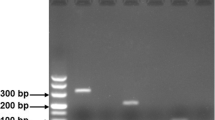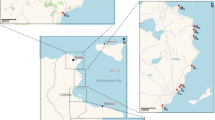Abstract
Various harmful microalgae coexist in the marine environment, seriously affecting the survival of aquatic animals, the sustainable development of fisheries, and pose a great threat to the safety of aquatic food. Consequently, monitoring these harmful microalgae in the marine aquaculture environment is an urgent issue that needs to be addressed. This paper focused on developing a multiplex polymerase chain reaction (MPCR) assay for the simultaneous detection of representative harmful microalgae commonly distributed in the aquaculture environment along the Chinese coast, including Karenia mikimotoi, Alexandrium tamarense, Chattonella marina, Prorocentrum minimum and Heterosigma akashiwo. First, the internal transcribed spacer and large subunit rDNA of target algal species were selected as target for the design of MPCR primers, the specificity of which was subsequently verified. Next, the MPCR system was established and the reaction conditions were optimized, including primer concentration, dNTP concentration, Mg2+ concentration, the concentration of Taq DNA polymerase, and annealing temperature. Specificity test showed that the established MPCR did not cross-react with all of the control algal species and thus can be used for specific detection of target algal species. The sensitivity test showed that the established MPCR could still detect all of the target algae when the concentration of genomic DNA was as low as 1 ng µL–1. Moreover, the MPCR could still detect K. mikimotoi when the concentration of genomic DNA was as low as 1 pg µL–1. The stability test indicated that the performance of the developed MPCR was not affected by the interfering algal species. In addition, the practicality of the established MPCR assay was evaluated using spiked water samples. The tests with the spiked samples indicated that the detection limit of MPCR for the all of the target algal species was approximately 4 cells mL−1, which can meet the requirement for the warning of HABs caused by them. In conclusion, the MPCR assay established here is characterized with strong specificity and good stability and is expected to be promising for daily monitoring of harmful microalgae in the aquaculture environment as an important alternative to traditional morphology-based methods.









Similar content being viewed by others
Data availability
All data generated or analyzed during this study are available upon reasonable request.
References
Ahn S, Kulis DM, Erdner DL, Anderson DM, Walt DR (2006) Fiber-optic microarray for simultaneous detection of multiple harmful algal bloom species. Appl Environ Microbiol 72:5742–5749
Ajani PA, Henriquez-Nunez HF, Verma A, Nagai S, Uchidaf H, Tesoriero MJ, Farrell H, Zammit A, Brette S, Murray SA (2022) Mapping the development of a Dinophysis bloom in a shellfish aquaculture area using a novel molecular qPCR assay. Harmful Algae 116:102253
Cai QS, Li RX, Zhen Y, Mi TZ (2006) Detection of two Prorocentrum species using sandwich hybridization integrated with nuclease protection assay. Harmful Algae 5:300–309
Chamberlain JS, Gibbs RA, Ranier JE, Nguyen PN, Caskey CT (1988) Deletion screening of the Duchenne muscular dystrophy locus via multiplex DNA amplification. Nucleic Acids Res 16:11141–11156
Chen NS, Chen Y (2021) Advances in the study of biodiversity of phytoplankton and red tide species in China (II): the East China Sea. Oceanolt Limnol Sin 52:363–384
Chen NS, Huang HL (2021) Advances in the study of biodiversity of phytoplankton and red tide species in China (I): the Bohai Sea. Oceanol Limnol Sinica 52:346–362
Chen NS, Zhang MJ (2021) Advances in the study of biodiversity of phytoplankton and red tide species in China (III): the South China Sea. Oceanol Limnol Sinica 52:385–401
Elabbadi A, Pichon J, Visseaux B, Schnuriger A, Bouadma L, Philippot Q, Patrier J, LabbéV RS, Fartoukh M, Timsit JM, Voiriot M (2020) Respiratory virus-associated infections in HIV-infected adults admitted to the intensive care unit for acute respiratory failure: a 6-year bicenter retrospective study (HIV-VIR study). Ann Intensive Care 10:123
Eso Y (2020) Microsatellite instability analysis using multiplex polymerase chain reaction with fluorescently labeled primers for amplification of five mononucleotide repeat markers. Hepatol Res 50:1391–1392
Fu HY, Zhang CY, Wang YY, Chen GF (2022) Advances in multiplex molecular detection technologies for harmful algae. Environ Sci Pollut R 29:43745–43757
Galal-Khallaf A (2021) Multiplex PCR and 12S rRNA gene sequencing for detection of meat adulteration: A case study in the Egyptian markets. Gene 764:145062
Gordon CA, Gray DJ, Gobert GN, McManus DP (2011) DNA amplification approaches for the diagnosis of key parasitic helminth infections of humans. Mol Cell Probe 25:143–152
Guillard RRL (1975) Culture of phytoplankton for feeding marine invertebrates. In: Smith WL, Chanley MH (eds) Culture of Marine Invertebrate Animals. Plenum Press, New York, pp 29–60
Guillebault D, Medlin LK (2020) Application of the μAqua microarray for pathogenic organisms across a marine/freshwater interface. Harmful Algae 92:1–16
Guo H, Ding DW, Lin FA, Guan CJ (2015) Characteristics and patterns of red tide in China coastal waters during the last 20a. Adv Mar Sci 33:547–558
Guo M, Suo YP, Bi SD, Guo JJ, Yang WL, Zhang XY, Ba DM, Wang JY, Cai XF (2020) Application of DNA-based methods for the identification of cod fish and its products. J Food Safe Qual 11:7700–7707
Han JY, Han SB (2020) Febrile seizures and respiratory viruses determined by multiplex polymerase chain reaction test and clinical diagnosis. Children 7:234
Handy SM, Hutchins DA, Cary SC, Coyne KJ (2006) Simultaneous enumeration of multiple raphidophyte species by quantitative real-time PCR: capabilities and limitations. Limnol Oceanogr: Meth 3:193–204
Heide BR, Heir E, Holck A (2008) Detection of eight GMO maize events by qualitative, multiplex PCR and fluorescence capillary gel electrophoresis. Eur Food Res Technol 227:527–535
Holck AL, Dromtorp SM, Heir E (2009) Quantitative, multiplex ligation-dependent probe amplication for the determination of eight genetically modied maize events. Eur Food Res Technol 230:185–194
Jae SA, Seung IS, Jinseob K, Kim T, Kang JG, Kim HS, Shin WG, Jang MK, Kim HY (2020) Efficacy of stool multiplex polymerase chain reaction assay in adult patients with acute infectious diarrhea. World J Clin Cases 8:3708–3717
Kang M, Park M, Kim KE, Lee T (2020) Development of a nuclease protection assay with sandwich hybridization (NPA-SH) to monitor Heterosigma akashiwo. J Life Sci 30:26–31
Kim H, Kang N, An K, Koo J, Kim MS (2016) MRPrimerW: a tool for rapid design of valid high-quality primers for multiple target qPCR experiments. Nucleic Acids Res 44:W259–W266
Kreer C, Dring M, Lehnen N, Ercanoglu MS, Gieselmann L, Luca D, Jain K, Schommers P, Pfeifer N, Klein F (2020) openPrimeR for multiplex amplification of highly diverse templates. J Immunol Meth 480:112752
Lin SJ, Ji NJ, Luo H (2019) Recent progress in marine harmful algal bloom research. Oceanol Limnol Sinica 50:495–510
Liu FG, Zhang CY, Wang YY, Chen GF (2022) A review of the current and emerging detection methods of marine harmful microalgae. Sci Total Environ 815:152913
Liu FG, Zhang CY, Zheng HW, Yang YC, Zang DY, Wang YY, Chen GF (2021) Rapid and sensitive detection of Karlodinium veneficum by a novel double-nick rolling circle amplification. Environ Sci Pollut Res 28:42570–42582
Loukas C, Mcquillan JS, Laouenan F, Tsaloglou M, Ruano-Lopez JM, Mowlem MC (2017) Detection and quantification of the toxic microalgae Karenia brevis using lab on a chip mRNA sequence-based amplification. J Microbiol Methods 139:189–195
Main CC, Greenfield DI, Doll C, Wang YF, Whereat EB, Mortensen R, Pettay DT, Coyne KJ (2018) Critical comparison of molecular methods for detection and enumeration of the harmful algal species, Heterosigma akashiwo, in environmental water samples. J Appl Phycol 30:2425–2434
Moestrup Ø, Akselmann-Cardella R, Churro C, Fraga S, Hoppenrath M, Iwataki M (Eds) (2020 onwards). IOC-UNESCO Taxonomic Reference List of Harmful Micro Algae. Accessed at http://www.marinespecies.org/habon2020-05-25. Accessed 25 May 2020
Nakano S, Tomaru Y, Kubota T, Takase H, Mochizuki M, Shimizu N, Sugita S (2020) Multiplex solid-phase real-time polymerase chain reaction without DNA extraction: a rapid intraoperative diagnosis using microvolumes. Ophthalmology 128:729–739
Onmaz NE, Yildirim Y, Karadal F, Hizlisoy H, Al S, Gungor C, Disli HB, Barel M, Dishan A, Tegin RAA, Simsek E (2020) E scherichia coli O157 in fish: prevalence, antimicrobial resistance, biofilm formation capacity, and molecular characterization. LWT- Food Sci Technol 133:109940
Orozcoa J, Medlin LK (2011) Electrochemical performance of a DNA-based sensor device for detecting toxic algae. Sensors Actuators B 153:71–77
Ou TP, Yun C, Auerswald H, In S, Leang R, Huy R, Choeung R, Dussart P, Duong V (2020) Improved detection of dengue and Zika viruses using multiplex RT-qPCR assays. J Virol Methods 282:113862
Pearson LA, D’Agostino PM, Neilan BA (2021) Recent developments in quantitative PCR for monitoring harmful marine microalgae. Harmful Algae 108:102096
Ramos-Ramírez LD, SaldañaAhuactzi Z, MoralesLara L (2020) Isolation and identification of two Brucella species from a Volcanic Lake in Mexico. Curr Microbiol 77:3565–3572
Sakamoto S, Lim WA, Lu DD, Dai XF, Orlova T, Iwataki M (2020) Harmful algal blooms, and associated fisheries damage in East Asia: Current status and trends in China, Japan, Korea, and Russia. Harmful Algae 102:101787
Scholin CA, Herzog M, Sogin M, Anderson DM (1994) Identification of group-and strain-specific genetic markers for globally distributed Alexandrium (Dinophyceae). II. Sequence analysis of a fragment of the LSU rRNA gene. J Phycol 30:999–1011
Scholin CA, Buck KR, Britschgi T, Cangelosi G, Chavez F (1996) Identification of Pseudo-nizschia australis (Bacillariophyceae) using rRNA targeted probes in whole cell and sandwich hybridization formats. Phycologia 35:190–197
Scorzetti G, Brand LE, Hitchcock GL, Rein KS, Sinigalliano CD, Fell JW (2009) Multiple simultaneous detection of harmful algal blooms (HABs) through a high throughput bead array technology, with potential use in phytoplankton community analysis. Harmful Algae 8:196–211
Settanni L, Corsetti A (2007) The use of multiplex PCR to detect and differentiate food- and beverage-associated microorganisms: A review. J Microbiol Methods 69:1–22
Shrestha HK, Hwu KK, Chang MC (2010) Advances in detection of genetically engineered crops by multiplex polymerase chain reaction methods. Trends Food Sci Technol 21:442–454
Wang L, Chen GF, Zhang CY, Wang YY, Sun R (2020) Application of loop-mediated isothermal amplification combined with lateral flow dipstick to rapid and sensitive detection of Alexandrium catenella. Environ Sci Pollut Res 27:4246–4257
Wipaporn W, Rungtiwa N, Amonrat J, Leelayuwat C (2020) Quantitative multiplex real-time reverse transcriptase–polymerase chain reaction with fluorescent probe detection of killer immunoglobulin-like receptors, KIR2DL4/3DL3. Diagnostics 10:588
Yan T, Li XD, Tan ZJ, Yu RC, Zou JZ (2022) Toxic effects, mechanisms, and ecological impacts of harmful algal blooms in China. Harmful Algae 111:102148
Zhang CY, Yang YC, Liu FG, Wang YY, Chen GF (2022) Recombinase polymerase amplification combined with lateral flow dipstick for the rapid detection of Chattonella marina. J Appl Phycol 34:1607–1620
Zhou PP, Zhang JZ, You YH, Wu YN (2008) Detection of genetically modified crops by combination of multiplex PCR and low-density DNA microarray. Biomed Environ Sci 21:53–62
Funding
This work was supported by Shandong Provincial Natural Science Foundation, China (ZR2020MD081; ZR2023MD085); the National Scientific Foundation of China (No. 31600309); HIT Scientific Research Innovation Fund (No. 2022KYCXJJ07).
Author information
Authors and Affiliations
Contributions
Guofu Chen and Yuanyuan Wang contributed to the conception of the study; Chunyun Zhang and Yihan Wang performed the experiment and wrote the main manuscript text;Fuguo Liu performed the data analyses; and all authors reviewed the manuscript.
Corresponding authors
Ethics declarations
Competing interests
The authors declare that they have no known competing financial interests or personal relationships that could have appeared to influence the work reported in this paper.
Additional information
Publisher's Note
Springer Nature remains neutral with regard to jurisdictional claims in published maps and institutional affiliations.
Rights and permissions
Springer Nature or its licensor (e.g. a society or other partner) holds exclusive rights to this article under a publishing agreement with the author(s) or other rightsholder(s); author self-archiving of the accepted manuscript version of this article is solely governed by the terms of such publishing agreement and applicable law.
About this article
Cite this article
Zhang, C., Wang, Y., Wang, Y. et al. Establishment of a multiplex polymerase chain reaction assay for the detection of marine harmful algae. J Appl Phycol 36, 243–258 (2024). https://doi.org/10.1007/s10811-023-03112-x
Received:
Revised:
Accepted:
Published:
Issue Date:
DOI: https://doi.org/10.1007/s10811-023-03112-x




